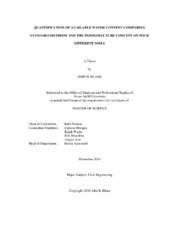| dc.description.abstract | The purpose of this study is to evaluate the use of the pedostructure soil concept to determine the available water within soil. Specifically, the hydro-structural behavior of the soil in the pedostructure is compared to standard methods of determining field capacity and permanent wilting point. The standard methods evaluated are: the FAO texture estimate, Saxon and Rawls’ pedotransfer functions, and the pressure plate method. Additionally, there are two pedostructure methods that are assessed: the water retention curve (WRC) and the soil shrinkage curve (ShC) methods. Three different types of soils were used: 1) Loamy Fine Sand: Undisturbed cores: Millican, Texas, USA; 2) Silty Loam: Reconstituted cores: Versailles soil, France; and 3) Silty clay loam: Reconstituted cores, Rodah Soils, Qatar. The results showed that the water contents at specific water potentials, empirically suggested values, of 330 hPa and 15,000 hPa for estimating the field capacity and permanent wilting point, respectively the three standards methods and the pedostructure WRC method were in relative agreement. On the other hand, the ShC method used transition characteristic points in the shrinkage curve to estimate the field capacity and permanent wilting point and was significantly higher. For example, in the fine sandy loam Ap horizon analyzed in this study, the filed capacity estimates by standard and WRC methods ranged from 0.073 to 0.150 m^3H2O/m^3Soil while the ShC method estimate was 0.342 m^3H2)/m^3Soil. Overall, it is evident that the process of extracting parameters from the ShC that correlate to the field capacity point of a soil always results in a larger amount of available water. One potential reason for the higher values could be in the selection of the transition point that represents the field capacity. Therefore, it is suggested to have further research to identify the most suitable characteristic point on the shrinkage curve to represent the field capacity value. | en |


